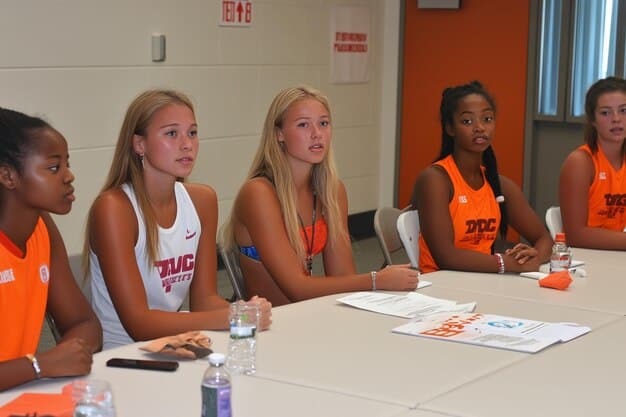NIL Rules: Shaping College Athlete Endorsement Deals in 2025

The evolving NIL landscape in 2025 continues to empower college athletes, allowing them to monetize their name, image, and likeness through endorsement deals, significantly reshaping collegiate sports economics and offering unprecedented opportunities for student-athletes.
The world of college sports is in constant flux, but few changes have been as transformative as the advent of Name, Image, and Likeness (NIL) rules. These regulations have fundamentally altered the relationship between student-athletes, universities, and the commercial world, creating a dynamic new ecosystem. Understanding College Athlete Endorsement Deals: How New NIL Rules Are Shaping the Landscape in 2025 is crucial for anyone interested in the future of collegiate athletics and the burgeoning opportunities for young talent.
The Genesis of NIL: A Paradigm Shift
The concept of amateurism in college sports, long perceived as a cornerstone, faced increasing scrutiny over decades. Student-athletes, generating billions for their institutions, were legally barred from profiting from their own name, image, and likeness. This created a significant disparity, where coaches, administrators, and universities thrived financially, while the athletes themselves received only scholarships and limited stipends. The pressure for change mounted from various fronts, including legal challenges, athlete advocacy groups, and evolving societal perceptions.
The turning point arrived in 2021 when the NCAA, under immense pressure, suspended its long-standing NIL rules, effectively opening the door for student-athletes to engage in endorsement deals. This was not a singular, uniform rule change, but rather a patchwork of state laws, institutional policies, and NCAA guidelines that continue to evolve. By 2025, this landscape has matured, bringing both clarity and new complexities to college athlete endorsements.
From Amateurism to Entrepreneurship
The shift from a strictly amateur model to one that embraces athlete entrepreneurship represents a profound ideological change. Athletes are no longer just representatives of their schools; they are brands in their own right, with marketable identities. This has encouraged a new wave of financial literacy and business acumen among young athletes, often while balancing demanding academic and athletic schedules. The early days saw a flurry of activity, from local deals to national campaigns, testing the boundaries of these new freedoms.
The motivations behind this seismic shift were multi-faceted. Legal challenges, primarily the Supreme Court’s Alston v. NCAA decision, highlighted the antitrust implications of restricting athlete compensation. Public opinion also swayed heavily in favor of athletes gaining control over their economic opportunities. As a result, the “amateur” ideal, once held sacrosanct, has given way to a more equitable, albeit complex, commercial reality.
Key drivers for the NIL implementation include:
- Legal Pressures: Court rulings challenging NCAA’s amateurism model.
- Athlete Advocacy: Growing demands from student-athletes for fair compensation.
- Financial Disparity: Recognition of the vast revenues generated by athletes for institutions.
- Market Forces: The undeniable commercial value of popular student-athletes.
This initial period laid the groundwork for the more structured and sophisticated NIL environment we see taking shape in 2025. What began as a somewhat chaotic free-for-all has now started to coalesce into a more organized, albeit still dynamic, system of endorsements and partnerships.
Essentially, the NIL rules acknowledge that student-athletes, like any other individual, should have the right to financially benefit from their own identity. This foundational change has ripple effects across recruitment, compliance, and the very culture of college sports.
Understanding the Current NIL Framework in 2025
By 2025, the NIL framework, while still evolving, has gained a semblance of structure compared to its initial rollout. The current landscape is characterized by a blend of federal guidelines, state laws, and institutional policies, creating a nuanced environment for college athletes. Athletes now navigate a system that requires careful consideration of compliance, agency, and personal brand management. The overarching goal remains to empower athletes to monetize their name, image, and likeness, but within a regulated framework designed to maintain competitive balance and educational integrity.
Federal oversight, though debated, has yet to yield a comprehensive national NIL law. This absence means state laws continue to play a significant role, often dictating what is permissible within their respective jurisdictions. Universities, in turn, have developed their own institutional policies to complement or, in some cases, supersede state regulations, adding another layer of complexity. These layers necessitate a robust support system for athletes, often involving compliance officers, legal counsel, and marketing professionals.
State Laws vs. Federal Oversight
The absence of a uniform federal NIL law has resulted in a patchwork of state legislation, each with its own nuances. Some states have restrictive rules, while others offer more latitude. This disparity can create an uneven playing field, potentially influencing recruiting decisions as athletes and their families seek out states with more favorable NIL environments. Efforts at the federal level to establish universal guidelines have been ongoing, but consensus has been difficult to achieve, leaving the state-by-state model largely intact for now.
For instance, some state laws might explicitly prohibit deals related to certain industries (e.g., gambling, alcohol), while others might be more lenient. These variations necessitate that athletes, agents, and brands perform due diligence to ensure compliance. The continuous debate around federal intervention underscores the dynamic nature of this policy area, with stakeholders constantly advocating for their preferred approach. This ongoing legislative dialogue is a defining characteristic of the NIL era.
The lack of a single federal standard also poses challenges for enforcement and consistency. What might be permissible for an athlete in California could be prohibited for an athlete in Texas, leading to potential disadvantages or advantages depending on geographical location. This complex legal patchwork is one of the most significant features of the 2025 NIL landscape.
Universities are also compelled to tread carefully, often relying on “safe harbor” provisions or federal antitrust exemptions while navigating these varied legal frameworks. Their primary concern is often internal compliance and protecting the institution from potential violations, showcasing the intricate balance between athlete autonomy and institutional responsibility.
The varying state approaches contribute to a competitive environment where schools in states with more liberal NIL policies may find themselves with a recruiting edge. This dynamic creates continued pressure for either federal standardization or a move towards broader, more permissive state laws.
Impact on Recruitment and Athlete Decision-Making
The introduction of NIL rules has fundamentally altered the recruitment landscape in college sports. Previously, a university’s reputation, coaching staff, and athletic facilities were the primary determinants for aspiring athletes. While these factors remain crucial, the financial opportunities presented by NIL deals have added a powerful new dimension to the decision-making process. Recruits now consider not only the athletic program but also the potential for lucrative endorsement deals offered within that school’s specific market and compliance environment.
This shift has led to a more business-minded approach by athletes and their families. They are increasingly evaluating universities based on their ability to facilitate NIL opportunities, whether through strong alumni networks, partnerships with local businesses, or dedicated NIL support staff. This has intensified competition among schools, moving beyond just athletic prowess to encompass economic potential. The ability to secure significant NIL income can be a powerful differentiator in a crowded recruiting market.
The “NIL Factor” in Choosing a School
The “NIL factor” has become an undeniable consideration for top recruits. Athletes are looking at a school’s location (major metropolitan areas often offer more brand opportunities), its fan base (larger, more passionate fan bases translate to more social media engagement and marketability), and its existing network of NIL collectives. These collectives, often independent of the university, play a crucial role in pooling resources to create endorsement opportunities for athletes. Therefore, choosing a school isn’t just about playing time or championships; it’s also about building a personal brand and financial future.
Recruiting pitches now frequently include discussions about potential NIL earnings, transparency around institutional support, and success stories of current athletes. This necessitates university athletic departments to adopt more sophisticated strategies that integrate NIL opportunities seamlessly into their overall recruitment efforts. The narrative has shifted from purely athletic development to holistic athlete development, inclusive of financial empowerment.
The implications of this shift are far-reaching:
- Increased Athlete Leverage: Recruits have more power in negotiating their collegiate destinations.
- New Recruiting Battlegrounds: Schools compete on NIL potential as much as traditional athletic merits.
- Focus on Brand Building: Athletes often seek institutions that can help enhance their marketability.
- Financial Advisors: More athletes and families engage with professionals to navigate NIL.
This new dynamic demands that universities not only invest in their athletic programs but also in robust NIL support systems to attract and retain top talent. The schools that adapt most effectively to this NIL-driven recruitment model are likely to thrive in the competitive collegiate landscape of 2025 and beyond.
Furthermore, the reputation of a school’s NIL collective or its dedication to athlete brand development can significantly sway a recruit’s decision. This pushes universities to foster strong relationships with local businesses and alumni to create a supportive ecosystem for their student-athletes to maximize their earning potential.
The Rise of NIL Collectives and Agencies
The burgeoning NIL marketplace has given rise to new and influential entities: NIL collectives and athlete agencies. These organizations have become critical intermediaries, connecting college athletes with brands and opportunities, and often managing the complexities of endorsement deals. By 2025, their role has become indispensable, shaping how athletes navigate their new financial freedoms and transforming the operational aspects of college sports.
NIL collectives are typically independent organizations, often formed by booster groups or university alumni, with the primary goal of creating NIL opportunities for student-athletes at a specific institution. They pool resources from donors and businesses to facilitate deals, ensuring athletes can monetize their name, image, and likeness without direct university involvement. This independence is key to maintaining NCAA compliance, as universities are generally prohibited from directly inducing athletes with NIL deals.
Collectives and Third-Party Facilitators
Collectives have evolved from informal groups to sophisticated operations with professional staff. They provide a range of services, from identifying potential brand partners to structuring deals and ensuring compliance with state laws and institutional policies. Their existence underscores the demand for structured support in the NIL space, as individual athletes often lack the time, resources, or legal expertise to manage these complex arrangements themselves.
Athlete agencies, traditionally focused on professional sports, have also expanded their services to college athletes. These agencies offer expertise in brand valuation, contract negotiation, and long-term career planning. They act as fiduciaries for athletes, ensuring they receive fair compensation and that their deals align with their personal brand and values. The increasing involvement of these professional entities is a clear indicator of the growing maturity and professionalism of the NIL market.

The services provided by these entities are vital for maximizing athlete potential:
- Opportunity Sourcing: Identifying and securing relevant endorsement deals.
- Negotiation and Contracts: Ensuring favorable terms and legal compliance.
- Brand Management: Guiding athletes in building and protecting their personal brand.
- Financial Literacy: Educating athletes on managing their earnings and taxes.
The symbiotic relationship between athletes, collectives, and agencies is a defining feature of the 2025 NIL landscape. It provides a necessary infrastructure, allowing athletes to focus on their academic and athletic pursuits while navigating the commercial opportunities now available to them.
However, the rise of collectives also raises questions about competitive equity and potential for inducement, leading to ongoing discussions among regulators and stakeholders about their appropriate role and transparency. Their significant influence in recruiting and retaining talent continues to be a central topic in the NIL discourse.
Navigating Compliance and Ethical Considerations
While NIL rules have ushered in a new era of athlete empowerment, they have also introduced a complex web of compliance challenges and ethical considerations. For institutions, athletes, and brands alike, navigating these waters effectively is paramount to avoiding penalties, maintaining integrity, and ensuring the sustainability of the NIL model. By 2025, understanding the nuances of compliance has become a specialized field within collegiate athletics.
The primary concern revolves around preventing NIL deals from becoming disguised “pay-for-play” schemes or improper inducements for recruits. While athletes can profit from their NIL, compensation cannot be directly tied to athletic performance or a commitment to a specific institution. This distinction, though seemingly clear, can be blurry in practice, leading to intense scrutiny from the NCAA and other regulatory bodies.
Key Compliance Challenges
Universities have invested heavily in compliance staff and educational programs to help athletes, coaches, and boosters understand the intricacies of NIL. Training sessions often cover topics such as permissible activities, disclosure requirements, and the consequences of non-compliance. Brands engaging with college athletes also need to be mindful of these regulations, as their partnerships can be subject to review.
Ethical considerations extend beyond mere rule-following. They encompass issues of fairness, transparency, and the potential for exploitation. Critics worry that some athletes, particularly those from disadvantaged backgrounds, might be pressured into unfavorable deals without adequate guidance. Ensuring that athletes have access to independent legal counsel and financial advice is crucial to mitigating these risks.
Major compliance and ethical concerns include:
- Inducement: Preventing NIL from being used to unlawfully recruit athletes.
- Disclosure: Ensuring transparency of all NIL activities to prevent hidden payments.
- Athlete Education: Equipping athletes with the knowledge to make informed decisions.
- Fair Market Value: Determining that deals are for actual services, not just disguised payments.
The continuous evolution of NIL policies means that what is permissible today might change tomorrow, requiring constant vigilance and adaptation from all parties involved. This dynamic regulatory environment underscores the need for robust institutional oversight and ongoing athlete education.
Moreover, the ethical imperative includes safeguarding athlete well-being, ensuring that the pursuit of NIL opportunities does not detract from their primary roles as students and athletes. Striking this balance is a continuous challenge for institutions and individuals within the NIL ecosystem.
The Future Outlook: Trends and Predictions for NIL in 2025 and Beyond
As we delve deeper into 2025, the NIL landscape is far from static; it’s a dynamic environment constantly shaped by legal challenges, market forces, and evolving interpretations. Predicting its future trajectory requires an understanding of current trends and potential regulatory shifts. The foundational principles of athlete endorsement are solid, but the operational details are still in flux, hinting at exciting and challenging developments ahead.
One major ongoing discussion centers around the potential for a unified federal NIL law. While bipartisan efforts have been made, comprehensive legislation remains elusive. However, the pressure for such a law is intensifying, driven by calls for a level playing field across states and a more consistent regulatory environment for universities and athletes. If enacted, a federal law could streamline compliance and provide greater clarity, potentially leading to a more stable and predictable NIL market.
Evolving Commercial Opportunities
Beyond legislation, the commercial opportunities for college athletes are expected to diversify and professionalize further. Expect to see more sophisticated brand partnerships, leveraging data analytics to match athletes with brands whose values and target audiences align. This will move beyond simple social media endorsements to include long-term ambassadorships, product development collaborations, and even equity stakes in startups, positioning athletes as true business partners rather than just endorsers.
Another trend is the increasing collaboration between universities and third-party NIL service providers. While universities currently cannot directly facilitate deals, they are investing in educational resources, brand-building workshops, and networking events to empower their athletes. This supportive infrastructure is only anticipated to grow, offering comprehensive programs that combine academic support with NIL strategy and financial literacy. The integration of NIL into the holistic athlete experience will become even more pronounced.
Key projections for the future of NIL include:
- Federal Regulation: Increased likelihood of a national NIL framework.
- Sophisticated Partnerships: Brands moving towards more strategic and long-term engagements.
- University Support: Enhanced institutional resources for athlete brand building and financial education.
- Technology Integration: Platforms and AI tools facilitating deal-making and compliance.
The NIL market in 2025 and beyond will likely be characterized by greater structure, increased professionalism, and a continued emphasis on athlete empowerment. However, it will also demand ongoing adaptability from all stakeholders to navigate its evolving complexities and maximize its potential.
The role of technology, particularly AI and data analytics, in connecting athletes with brands and managing compliance is also set to expand. Platforms designed to track NIL deals, calculate fair market value, and ensure regulatory adherence will become standard tools in the ecosystem, further professionalizing the process.
Challenges and Criticisms of the NIL Era
While the NIL era has brought unprecedented opportunities for college athletes, it has also been met with a fair share of challenges and criticisms. The rapid evolution of the rules, coupled with the inherent complexities of commercializing amateur sports, has created various pain points for athletes, universities, and regulators. By 2025, many of these issues persist, demanding continuous attention and innovative solutions to ensure the integrity and sustainability of collegiate athletics.
One of the most significant criticisms centers on the potential for competitive imbalance. Larger, wealthier institutions, particularly those in major media markets, may have an inherent advantage in generating more lucrative NIL opportunities for their athletes. This can create a “haves and have-nots” scenario, where smaller schools or those without robust booster networks struggle to compete for top talent, potentially exacerbating existing disparities in collegiate sports.
Addressing Equity and Transparency Concerns
Another pressing issue is transparency. The lack of standardized public reporting for NIL deals makes it difficult to ascertain the true scope of transactions and scrutinize potential improprieties. While some states require disclosure, a national system for tracking and auditing deals is still in development. The opacity of some deals fuels concerns about illicit payments, recruitment inducements, and even potential tax evasions, creating a regulatory challenge.
Ethically, there’s ongoing debate about the impact of NIL on the student-athlete experience. Critics fear that the pressure to secure and manage endorsement deals could detract from academic pursuits or athletic performance. Questions arise about how much time athletes spend on NIL activities versus their studies and training, and whether this new financial incentive system creates additional stress or a transactional mindset that undermines team cohesion.
Key challenges and criticisms include:
- Competitive Imbalance: Disparities in NIL opportunities favoring larger programs.
- Lack of Transparency: Difficulty in tracking and verifying deal legitimacy.
- Athlete Exploitation: Concerns about young athletes entering unfavorable contracts.
- Undefined Inducement: The fine line between legitimate NIL and recruitment incentives.
- Tax Implications: Athletes navigating complex tax laws for their NIL income.
For many, the NIL era represents an imperfect but necessary step towards athlete empowerment. However, addressing these criticisms through clearer regulations, enhanced transparency, and comprehensive athlete support systems will be crucial for the long-term health and credibility of college sports.
The mental and emotional toll of managing a personal brand and financial responsibilities alongside being a high-performance athlete is also a growing concern. Providing psychological and financial counseling becomes increasingly important to support athletes through these new pressures.
The Economic Ripple Effect of NIL on College Towns
The advent of NIL rules has generated a significant economic ripple effect, particularly noticeable in college towns across the United States. Beyond the immediate financial benefits for student-athletes, the new landscape has created direct and indirect economic stimulus, influencing local businesses, employment, and overall community growth. By 2025, this economic impact has become a tangible aspect of the NIL revolution, demonstrating its broader societal reach.
Local businesses in college towns are often the primary beneficiaries of NIL deals, especially for athletes who may not attract national brand attention but are stars within their local communities. Restaurants, car dealerships, apparel shops, and other small enterprises frequently partner with popular student-athletes for endorsements, appearances, and social media promotions. This not only provides income for the athletes but also boosts local advertising and customer engagement for these businesses.
Local Business Engagement and Growth
The increased commercial activity surrounding college athletes has also spurred the growth of support industries in these towns. This includes marketing agencies specializing in NIL, legal services for contract review, financial advisors for young athletes, and even new tech platforms designed to connect local brands with student-athletes. These emerging businesses create jobs and stimulate the local economy, contributing to a vibrant commercial ecosystem beyond just game days.
Moreover, the NIL phenomenon can enhance a college town’s overall brand value. Highly visible and successful athletes, through their NIL activities, can bring increased media attention to their universities and host cities, potentially attracting tourism, new residents, and further investment. The intertwining of athletic success, athlete popularity, and economic activity creates a positive feedback loop for these communities.
The economic benefits extend to various sectors:
- Direct Endorsements: Local restaurants, stores, and more engaging athletes.
- Service Providers: Growth of agencies, legal, and financial services supporting NIL.
- Increased Foot Traffic: Athlete appearances driving customers to local businesses.
- Community Engagement: Businesses leveraging athletes for localized advertising.
Ultimately, the NIL rules have transformed college sports from a purely institutional economic engine into a more distributed one, allowing significant portions of the commercial value to flow directly into the hands of athletes and, subsequently, into the local economies that host these universities. This broader distribution of wealth is a powerful, if often unheralded, aspect of the NIL era in 2025.
The heightened visibility and celebrity of successful athletes, amplified through local NIL deals, can also foster a stronger sense of community pride and engagement, indirectly benefiting the local economy through increased school support and consumer loyalty.
| Key Aspect | Brief Description |
|---|---|
| 📊 NIL Rules Evolution | From chaotic rollout to a more structured, but still dynamic, legal and commercial framework for athlete endorsements. |
| recruits Recruitment Impact | NIL opportunities are now a significant factor for athletes choosing institutions, creating new competitive dynamics. |
| 🤝 Collectives & Agencies | Independent groups and professional agencies are crucial for connecting athletes with brands and managing deals. |
| ⚖️ Compliance & Ethics | Navigating complex state laws and NCAA guidelines to prevent pay-for-play and exploitation of athletes. |
Frequently Asked Questions About NIL Deals
NIL rules allow college athletes to profit from their Name, Image, and Likeness through endorsement deals. They originated from increasing legal pressure, athlete advocacy, and the NCAA’s shift from strict amateurism, culminating in the suspension of previous restrictions in 2021.
NIL collectives are typically independent organizations, often funded by boosters or alumni, that pool resources to create endorsement opportunities for student-athletes at a specific university. They facilitate deals, manage contracts, and ensure compliance without direct institutional involvement.
As of 2025, there is no comprehensive federal law specifically governing NIL deals. The landscape is currently dictated by a patchwork of state laws and institutional policies, leading to varied regulations across different jurisdictions and ongoing discussions for federal oversight.
NIL has profoundly impacted recruitment by making potential endorsement income a significant factor for aspiring athletes. Universities now compete not only on athletic merits but also on their ability to facilitate NIL opportunities, influencing athlete decision-making and intensifying competition.
Main criticisms include competitive imbalances favoring larger schools, lack of transparency in deals, concerns about athlete exploitation, the blurry line between legitimate NIL and recruitment inducements, and potential distractions from academic and athletic priorities for student-athletes.
Conclusion
The landscape of college athlete endorsement deals, shaped by the evolving NIL rules in 2025, represents a significant and irreversible transformation in collegiate sports. What began as a contentious debate has matured into a complex, multifaceted system that empowers student-athletes with unprecedented financial autonomy. While challenges concerning compliance, competitive equity, and ethical considerations persist, the overall trajectory points towards a more professionalized and athlete-centric model. The ripple effects, from intensified recruitment to localized economic booms, underscore the profound impact of NIL on universities, communities, and the very fabric of college athletics. As stakeholders continue to adapt and refine practices, the NIL era promises to redefine the collegiate experience, fostering a new generation of empowered student-entrepreneurs who can finally capitalize on their hard-earned name, image, and likeness.





